Happy Halloween from OneTubeRadio.com!
The illustration of these thoroughly modern witches appeared in Radio Craft, October 1944.

Happy Halloween from OneTubeRadio.com!
The illustration of these thoroughly modern witches appeared in Radio Craft, October 1944.
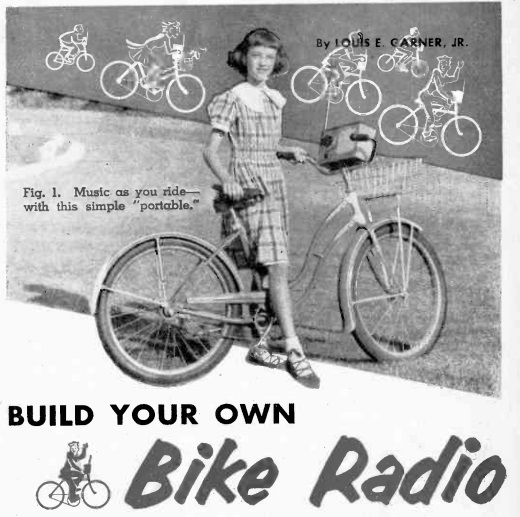 Seventy years ago, this young woman was the proud owner of a bicycle radio. As she rode, she could listen to music, or perhaps a ball game.
Seventy years ago, this young woman was the proud owner of a bicycle radio. As she rode, she could listen to music, or perhaps a ball game.
The receiver was constructed according to plans in the very first issue of Popular Electronics, October 1954, and was a four-tube superheterodyne design. The project was somewhat involved, but the magazine promised that it was simple. Alignment was required, but according to the magazine, if you couldn’t locate a signal generator, a local radio technician or friendly radio amateur could do the job for you.
Of course, the magazine reminded that bike safety was important, and it cautioned readers not to get so engrossed in a radio program that they failed to watch traffic. The cabinet could be painted to match the bike, or personalized with some snappy decals.
Since the set was so easy to build, clubs could make them in an assembly line fashion so that members would have matching portables during jaunts together. In fact, once this girl started the fad, the magazine was willing to bet that other groups would be following in short order.
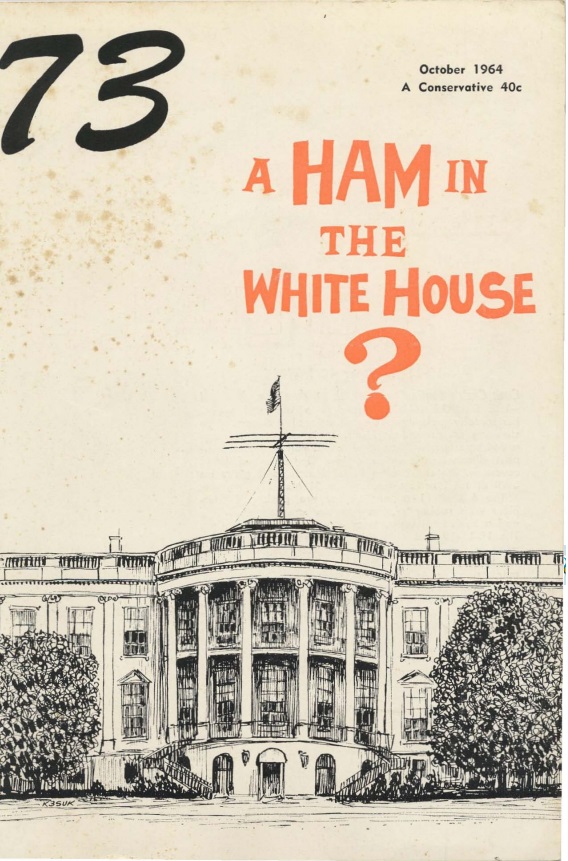 Sixty years ago, there was a prospect of a ham in the White House, namely, Barry Goldwater, K7UGA/K3UIG. The October 1964 issue of 73 Magazine showed the logical conclusion, namely, an antenna on the White House. And the following cartoons, by Wayne Pierce, K3SUK, appeared in that issue.
Sixty years ago, there was a prospect of a ham in the White House, namely, Barry Goldwater, K7UGA/K3UIG. The October 1964 issue of 73 Magazine showed the logical conclusion, namely, an antenna on the White House. And the following cartoons, by Wayne Pierce, K3SUK, appeared in that issue.
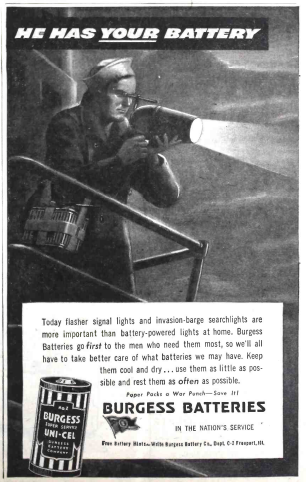 Eighty years ago, flasher signal lights and invasion -barge searchlights were more important than flashlights at home. Therefore, this ad from Burgess Batteries reminded readers that those needs came first, and whatever batteries made it into American homes had to be taken care of.
Eighty years ago, flasher signal lights and invasion -barge searchlights were more important than flashlights at home. Therefore, this ad from Burgess Batteries reminded readers that those needs came first, and whatever batteries made it into American homes had to be taken care of.
To do that, Americans needed to keep them cool and dry, use them as little as possible, and rest them as often as possible. The ad appeared 80 years ago this month in the October 1944 issue of Radio Craft.
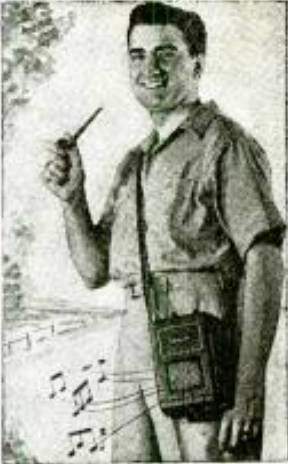 Eighty-five years ago this month, the October 1939 issue of Radio Craft featured the Motorola Model 41-S “Sporter,” weighing in at only 6-1/2 pounds. The antenna was an integral part of the shoulder strap, and the four-tube set was much to be desired. Publisher Hugo Gernsback had recently predicted that “when we go down to about 5 or 6 lbs.–a not impossible figure–we will have a receiver of much greater popularity,” and that time had come.
Eighty-five years ago this month, the October 1939 issue of Radio Craft featured the Motorola Model 41-S “Sporter,” weighing in at only 6-1/2 pounds. The antenna was an integral part of the shoulder strap, and the four-tube set was much to be desired. Publisher Hugo Gernsback had recently predicted that “when we go down to about 5 or 6 lbs.–a not impossible figure–we will have a receiver of much greater popularity,” and that time had come.
The article concluded with the further prediction: “Radio-Craft predicts that, now that radio sets are within sight of being really PORTABLE–so that milady can carry them a block without gasping for breath–the battery portable is destined to “go places” not
only in design, but also commercially!”
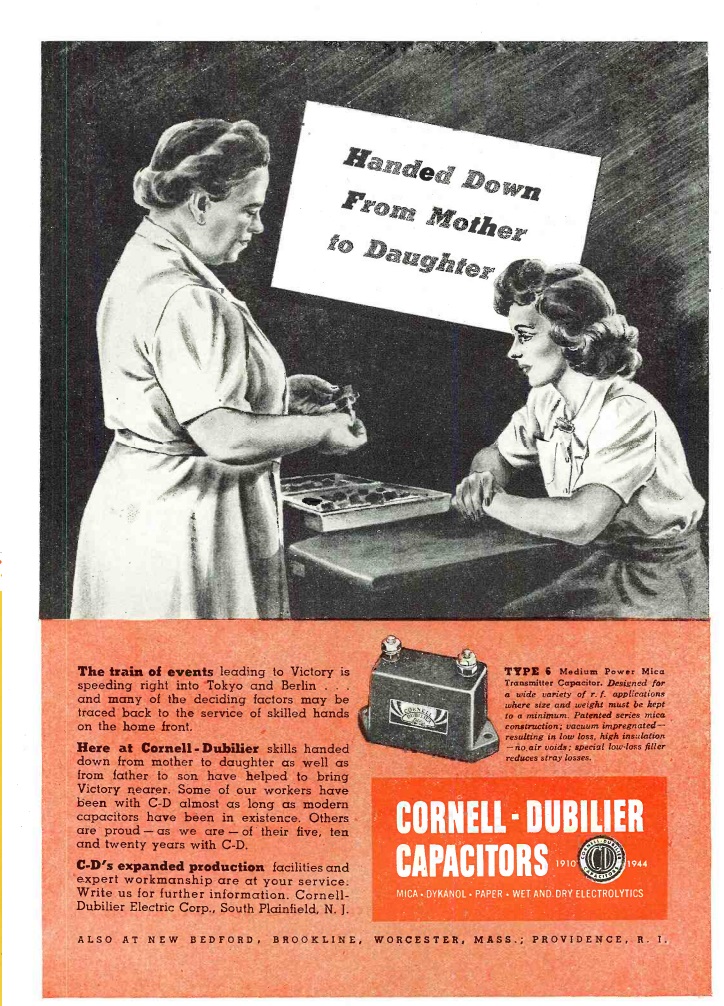 Eighty years ago, this mother-daughter duo are doing their part to defeat Hitler and Tojo, as Mom passes along the lore of capacitors. They both work at Cornell-Dubilier, and this ad, from the October 1944 issue of Radio News, points out that the company has been around almost as long as the modern capacitor has been in existence. With women hitting the workforce during the War, C-D points out that it’s not a new thing with them.
Eighty years ago, this mother-daughter duo are doing their part to defeat Hitler and Tojo, as Mom passes along the lore of capacitors. They both work at Cornell-Dubilier, and this ad, from the October 1944 issue of Radio News, points out that the company has been around almost as long as the modern capacitor has been in existence. With women hitting the workforce during the War, C-D points out that it’s not a new thing with them.
And just to let everyone know that they’re modern, they call their product “capacitors,” rather than the previously common “condenser” name.
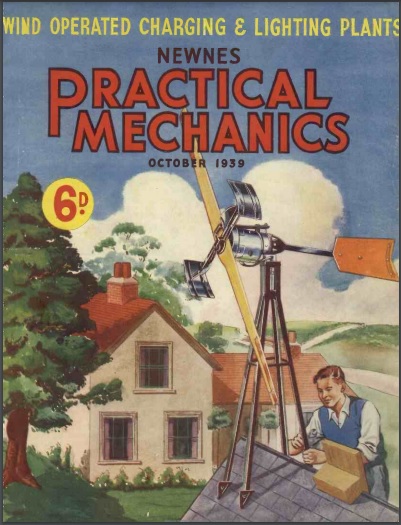 Britain was at war by the time the October 1939 issue of Pracical Mechanics hit the newsstands. Undoubtedly, much of the content had been written prior to hostilities. For example, the cover story gives some pointers on wind powered lighting plants for use in remote areas, and the magazine noted that most of the British Isles enjoyed at least eight hours per day of sufficient wind, although some planning was required as to the exact location. The gentleman shown here on the cover looks optimistic, and this view was probably from before the War.
Britain was at war by the time the October 1939 issue of Pracical Mechanics hit the newsstands. Undoubtedly, much of the content had been written prior to hostilities. For example, the cover story gives some pointers on wind powered lighting plants for use in remote areas, and the magazine noted that most of the British Isles enjoyed at least eight hours per day of sufficient wind, although some planning was required as to the exact location. The gentleman shown here on the cover looks optimistic, and this view was probably from before the War.
Wartime content was added, however, before the magazine went to press. The editorial, for example, pointed out that within the limitations imposed by the state, it was the duty of each citizen to carry on so as to cause as little disruption to national life as possible.
But the magazine also carried the extensive feature, a portion of which is shown below, with pointers on building an air-raid shelter. It noted that “regrettable though the fact may be, it seems evident that in these modern times the air-raid shelter constitutes a structure which, for some years at any rate, has come to stay.”
Seventy-five years ago, if you wanted to see the most exciting radio and TV show, all you had to do was go to your nearby Motorola dealer. This ad appeared in Life magazine 75 years ago today, October 17, 1949.
 Eighty-five years ago today, the October 15, 1939, issue of Broadcasting magazine carried this ad for the Green Hornet. The radio program had originated three years earlier on Detroit station WXYZ, and was carried on various networks over the years. This ad indicates that it was in syndication in 1939, with its roots still in Detroit. The ad promised a movie to be released soon, and it was indeed serialized in the 1940s.
Eighty-five years ago today, the October 15, 1939, issue of Broadcasting magazine carried this ad for the Green Hornet. The radio program had originated three years earlier on Detroit station WXYZ, and was carried on various networks over the years. This ad indicates that it was in syndication in 1939, with its roots still in Detroit. The ad promised a movie to be released soon, and it was indeed serialized in the 1940s.
The Green Hornet was actually the great nephew of the Lone Ranger, who also got his start on WXYZ.
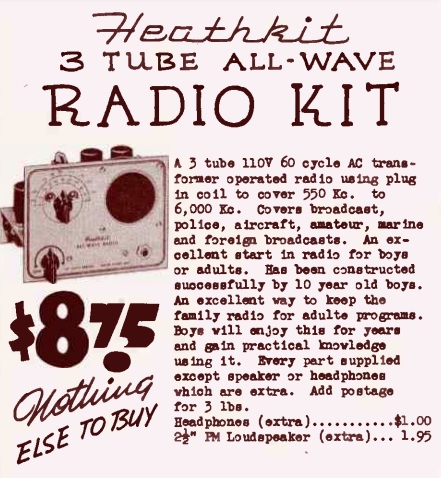 Shown here from 75 years ago is the Heathkit All-Wave Radio. While the ad does not specify the model number, it is the Model K-2, which had recently replaced the similar K-1 which came out the previous year. The set runs on AC power, using one 1626 triode as the rectifier, and a second 1626 as regenerative detector. The 12A6 amplifies the audio to power either headphones or speaker (the only components you need to buy separately, as everything else is included).
Shown here from 75 years ago is the Heathkit All-Wave Radio. While the ad does not specify the model number, it is the Model K-2, which had recently replaced the similar K-1 which came out the previous year. The set runs on AC power, using one 1626 triode as the rectifier, and a second 1626 as regenerative detector. The 12A6 amplifies the audio to power either headphones or speaker (the only components you need to buy separately, as everything else is included).
There’s a very informative article at the Orange County Amateur Radio Club website by AF6C. At that site, you can find a schematic and more information. The ad shown here is from Heath’s October 1949 flyer. The ad notes that the set can be built by either adults or boys–it apparently didn’t occur to them that a girl might want to build one. It had been successfully constructed by 10 year old boys and was billed as a great start in radio. Boys would enjoy it for years, and it had the added benefit of keeping the family radio for adult programs, while Junior listened to what he wanted.
It covered 550 kHz to 6 MHz, apparently with a single plug-in coil. It sold for $8.75 plus shipping, which works out to $115.73 in 2024 dollars. But chances are, Mom and Dad would be willing to cash in a war bond if it meant freeing up the family radio.